Abstract
Solar energy resources have been widely harvested through the use of photovoltaic cells. Nevertheless, its effectiveness is still tricky because the Sun’s heat is rarely considered. This study examined the performance of a photovoltaic-coupled thermoelectric generator. Temperature and light sensors were put in the photovoltaic system and linked to a data-collecting system. The result demonstrates that adding a thermoelectric generator lowers the photovoltaic temperature, increasing the combined solar and thermoelectric generator’s power and efficiency. The endeavor aims to create a more efficient solar system by improving its design.
1. Introduction
Modern civilizations have used enormous amounts of energy [1]. Fossil fuels, such as coal, oil, and gas, continue to be the primary sources of energy [2]. Despite rising energy use and demand, there remains a finite supply of fossil fuels. Furthermore, using them results in greenhouse gas emissions, exacerbating global warming [3]. Because of this, renewable energy sources—such as geothermal, solar, wind, and ocean tidal waves—are becoming increasingly critical to ensuring ongoing energy production and a safe planet for future generations [4].
The most environmentally friendly energy source for reducing the consumption of fossil fuels is solar energy [5]. Photovoltaic (PV) cells provide an attractive opportunity for effectively harnessing solar energy among the many solar energy technologies [6]. The benefits of the photovoltaic cell, which include creating pure, green energy without any mechanically rotating elements and providing accessibility to a sizable amount of energy input, have sparked much interest in the power production business. There is a certain degree of linear correlation between solar power and the electrical power generated by photovoltaic equipment. However, the photovoltaic module heats up when exposed to intense sun radiation, which reduces PV efficiency [7].
The amount of input energy the PV gains must still be raised. The energy provided by light is the only power source the PV produces. Heat energy is not exploited to its full potential. Recently, many hybrid solar and heat recovery systems have been developed to address this issue [8]. The first systems that integrated light and heat energy into a single module are hybrid PV-thermal systems [9]. Direct conversion of thermal energy to electrical power is most easily accomplished with a thermoelectric generator (TEG). By generating charge carriers due to a temperature differential between the TEG sides, the Seebeck effect allows the TEG to convert heat into electrical energy instantaneously [10,11,12]. Hybrid PV-TEG systems combine PV and thermal systems that use a TEG module [13,14]. Usually, the TEG is installed directly on the rear of the PV in a combined PV-TEG system. These integrated systems are more efficient than standalone PV systems claimed Babu and Ponnambalam [15], and such integrated systems are more efficient than standalone PV systems. Numerous examples of research, including that of Khan et al. [16], Gao et al. [17], and Sahari et al. [8], have reported on the performance of PV-TEG systems.
PV cells have been the subject of several investigations using hybrid techniques. Every approach has benefits and drawbacks, such as expense- and power-related issues. An inexpensive way to increase PV power is with a primary hybrid photovoltaic cell that uses thermoelectric gain (TEG). In this paper, PV and PV+TEG system performance are examined. A collective measurement is conducted to give comprehensive data, including power, PV temperature, and solar radiation. Furthermore, the PV efficiency is computed. The understanding of solar power extraction is anticipated to increase with the research of PV cells.
2. Experimental Methods
2.1. Experimental Tools
The solar cell and a hybrid photovoltaic cell with a thermoelectric generator were made possible by constructing two fixed panels. Figure 1a,b depicts a picture and schematic diagram of the panels that make up the two systems. Figure 2 describes some primary instruments mounted on the PV panel. Table 1 and Table 2 enumerate the PV and TEG requirements. The temperature of the PV surface was measured using a K-type thermocouple. The data logger, controlled using an Arduino Mega 2560 microcontroller, receives the signal from the thermocouple using a temperature sensor type MAX6675. Using an MAX471 electrical sensor, the PV output, which consists of voltage, current, and power, was measured. The sun radiation was measured using a light intensity sensor (model BH1750). To convert the solar radiation unit to an irradiance unit in W/m2, see [18]. Finally, the PV cell circuit’s load was a 4 V/4 Ah battery. Before collecting experimental data, every piece of equipment was calibrated.
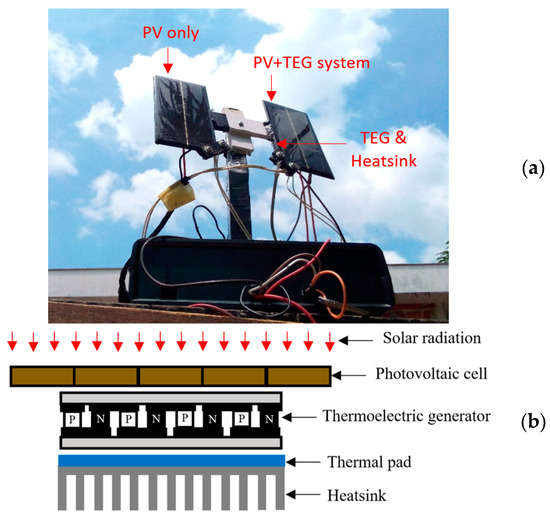
Figure 1.
Experiemntal tool set-up: (a) photograph and (b) scheamtic diagram.
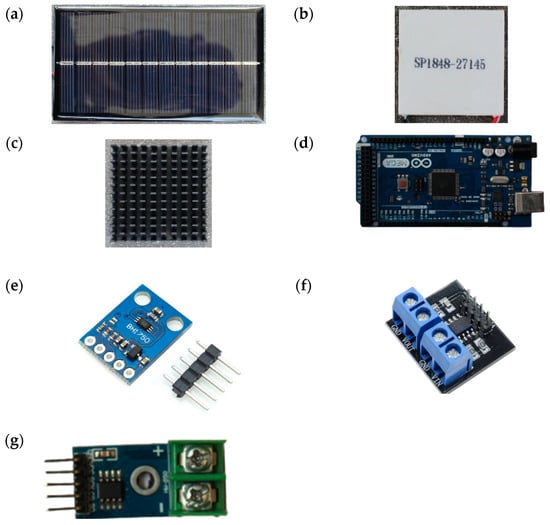
Figure 2.
(a) Photovoltaic cell. (b) Thermoelectric generator. (c) TEG heat exchanger. (d) Arduino MEGA 2560. (e) Light intensity sensor type BH175. (f) Electrical output sensor type MAX471. (g) Temperature sensor type MAX6675.

Table 1.
The PV specifications.

Table 2.
The TEG specifications.
2.2. Experimental Procedures
The experiment was carried out in Indonesia at S7°34′36.83″ latitude and E111°25′55.56″ longitude. The study day was characterized by bright, cloudless skies with an average humidity of 79.4%. Setting up the constructed panels was the first step of the experiment. A tilt angle of 66 for the fixed panel was used throughout the panel preparation process. With a 66 degree tilt angle toward the south, the PV cells were oriented with their faces facing upward perpendicularly. In Western Indonesia Time, the panels were operational from 5:00 a.m. to 6:00 p.m. However, data collecting may start once sunlight enters the PV and is recorded in a data logger. Light intensity, temperature, and electrical output were the three variables that were measured. Temperature, light intensity, and electrical power measurement instruments were calibrated for this study’s experiment data collection. With the aid of a conventional thermometer, the temperature of water was measured from a cold, ice-like state to a boiling point to calibrate the MAX6675 sensor. A temperature error of 0.625 °C was averaged. A 12 V DC 2 A light charged by an LW-301KDS DC power supply power source was utilized to calibrate the MAX471 sensor, which measured the electrical power, using a WH5000 multimeter, and 0.125 W was the power’s average uncertainty. The BH1750 sensor’s light intensity readings were adjusted with an AS803 light intensity meter. The light intensity uncertainty was 1.98 W/m2 on average. With Microsoft Excel, a typical error formula was utilized to compute the uncertainty analysis of the measurement data.
3. Results and Discussion
3.1. Light Intensity
The WH1750 sensor detected the sun’s radiation intensity, as shown in Figure 3. The data from the calculator web [19] was used for comparison. The outcome demonstrates that the panel’s solar radiation intensity rose with dawn, peaked at 11:55 a.m., and then fell. Except for a variance in time, the calculated data resembled the current experimental results in terms of curve trends. This result occurred because the calculation considered just the altitude angle, ignoring the geographic latitude and longitude angles, which caused a discrepancy in the Sun’s orbit. The panel’s maximum intensity was 989.16 W/m2. Nonetheless, the computation’s data revealed that around 11:00 am, the maximum light intensity value—1129.70 W/m2—occurred. The current work’s measurement of solar radiation intensity is consistent with previous research findings [20,21].
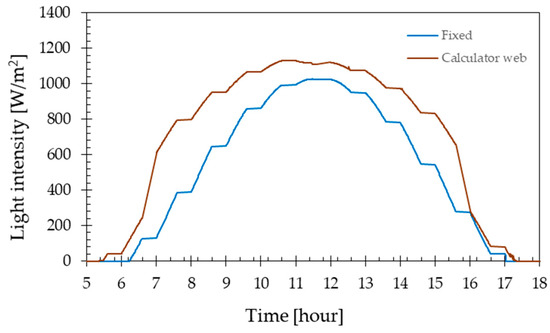
Figure 3.
Solar light intensity.
3.2. Temperature
The temperature profile observed on the surface of PV, PV+TEG, the TEG’s hot side, and the TEG’s cool side is displayed in Figure 4. A thermocouple attached to an MAX6675 sensor was used to conduct the measurement. The whole temperature showed a rise beginning at 5:00 am at 24 °C, peaking at 11:55 am, and then falling to 28 °C by 6:00 p.m. Because of the fitted thermoelectric module beneath the PV, which absorbs heat, the temperature of the PV was higher than that of the PV+TEG. The current outcome is consistent with Khan et al.’s [22] findings. Since the TEG was installed at the bottom of the PV, the temperature on the hot side of the TEG was nearly identical to that of the PV. Owing to heat dissipation via the thermal pad and heatsink, the temperature of the TEG cold side was significantly lower than that of the TEG’s hot side.
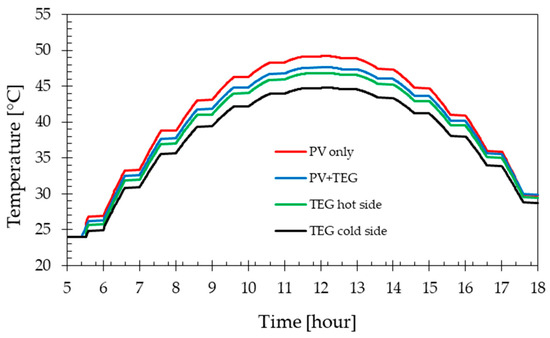
Figure 4.
Temperature profile of the PV, PV+TEG, and TEG systems.
3.3. Power Output
The output powers produced by the PV, PV+TEG, and TEG systems are displayed in Figure 5. Every system indicated that the power started at zero at around 6:00 a.m., peaked at that time, and then dropped to zero around 6:00 p.m. This curve indicates that sunlight generates power during the day. The PV+TEG system’s power output surpassed that of the PV cell. Furthermore, compared with PV systems, the TEG power was far lower. The PV, PV+TEG, and TEG systems had maximum powers of 0.66 W, 0.77 W, and 0.09 W, respectively. This finding is consistent with that of Fathabadi [23], showing that the TEG installment added to the PV cell’s improved power.
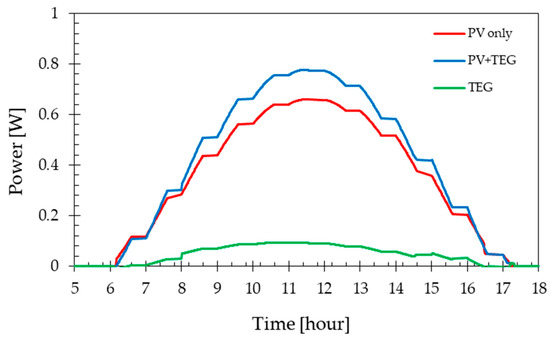
Figure 5.
Output power of the PV, PV+TEG, and TEG systems.
3.4. Efficiency
The PV and PV+TEG systems’ maximum efficiencies are shown in Figure 6. The outcome demonstrates that the PV+TEG system had a greater efficiency than PV. The efficiency ratings of the PV and PV+TEG systems were 7.7% and 10.6%, respectively. As shown in Figure 4, the drop in temperature in the PV+TEG system was responsible for the improvement in efficiency. Even though the examined PV systems use various cooling approaches, the current study’s loss in PV efficiency at lower temperatures is consistent with earlier research on PV applications by Sutanto et al. [24] and Dida et al. [21].
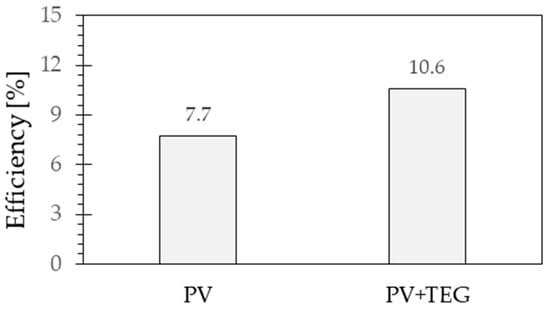
Figure 6.
Efficiency of the PV and PV+TEG systems.
4. Conclusions
PV and PV+TEG system performance was examined in this paper. A datalogger programmed with an Arduino board was used to measure and record the temperature and intensity of solar radiation on the PV cell. The outcome demonstrates that the TEG installation might lower the PV temperature. Compared with PV systems, the PV+TEG system had more power and efficiency. The highest powers of the PV, PV+TEG, and TEG systems were 0.66 W, 0.77 W, and 0.09 W, respectively. The PV and PV+TEG systems had efficiency ratings of 7.7% and 10.6%, respectively. The results of this study demonstrate that the TEG module enhances the PV cell’s performance.
Author Contributions
Conceptualization, T.W.B.R.; Methodology, A.I.S.; Software, A.I.S.; Validation, H. and A.H.; Formal analysis, T.W.B.R.; Investigation, A.I.S. and H.; Data curation, H. and A.H.; Writing—original draft, A.I.S. and T.W.B.R.; Supervision, T.W.B.R. and A.H.; Project administration, A.H.; Funding acquisition, H. and A.H. All authors have read and agreed to the published version of the manuscript.
Funding
The Research and Innovation Institute of Universitas Muhammadiyah Surakarta, with Doctorate research grant number 110.39/A.3-III/LRI/VI/2022, supplied the authors with the facilities and funding. The authors express their gratitude to the institute for their support.
Institutional Review Board Statement
Not applicable.
Informed Consent Statement
Not applicable.
Data Availability Statement
Data are contained within the article.
Conflicts of Interest
The authors declare no conflicts of interest.
References
- Muzayanah, I.F.U.; Lean, H.H.; Hartono, D.; Indraswari, K.D.; Partama, R. Population density and energy consumption: A study in Indonesian provinces. Heliyon 2022, 8, e10634. [Google Scholar] [CrossRef]
- Overland, I.; Juraev, J.; Vakulchuk, R. Are renewable energy resources more evenly distributed than fossil fuels? Renew. Energy 2022, 200, 379–386. [Google Scholar] [CrossRef]
- Efendi, R.; Indriyani, Y.A. Mini-Review: Green Roof As a Greenery Solution in Urbanized Settlements and Energy Saving in Buildings. Media Mesin Maj. Tek. Mesin 2022, 23, 91–98. [Google Scholar] [CrossRef]
- Zile, M. Optimisation of power quality in solar/wind power stations using developed artificial bee/ant hybrid heuristic algorithm. Appl. Res. Smart Technol. 2021, 2, 69–79. [Google Scholar] [CrossRef]
- Abdelrazik, M.K.; Abdelaziz, S.E.; Hassan, M.F.; Hatem, T.M. Climate action: Prospects of solar energy in Africa. Energy Rep. 2022, 8, 11363–11377. [Google Scholar] [CrossRef]
- Sourav Khanna KSReddy, T.K.M. Optimization of finned solar photovoltaic phase change material finned pv pcm) system. Int. J. Therm. Sci. 2018, 130, 313–322. [Google Scholar] [CrossRef]
- Maka, A.O.M.; Salem, S.; Mehmood, M. Solar photovoltaic (PV) applications in Libya: Challenges, potential, opportunities and future perspectives. Clean. Eng. Technol. 2021, 5, 100267. [Google Scholar] [CrossRef]
- Sahari, N.; Ngadiron, Z.; Azman, Z.; Mustapha, N.B.; Ismail, N. Development of Hybrid Photovoltaic and Thermoelectric Generator for Energy Harvesting. Int. J. Eng. Trends Technol. 2022, 70, 284–291. [Google Scholar] [CrossRef]
- Nathan, G.J.; Jafarian, M.; Dally, B.B.; Saw, W.L.; Ashman, P.J.; Hu, E.; Steinfeld, A. Solar thermal hybrids for combustion power plant: A growing opportunity. Prog. Energy Combust. Sci. 2018, 64, 4–28. [Google Scholar] [CrossRef]
- Atmoko, N.T.; Veza, I.; Riyadi, T.W.B. Study On The Energy Conversion In The Thermoelectric Liquefied Petroleum Gas Cooking Stove With Different Cooling Methods. Int. J. Eng. Trends Technol. 2021, 69, 185–193. [Google Scholar] [CrossRef]
- Atmoko, N.T.; Jamaldi, A.; Riyadi, T.W.B. An Experimental Study of the TEG Performance using Cooling Systems of Waterblock and Heatsink-Fan. Automot. Exp. 2022, 5, 361–367. [Google Scholar] [CrossRef]
- Riyadi, T.W.B.; Utomo, B.R.; Effendy, M.; Wijayanta, A.T.; Al-Kayiem, H.H. Effect of thermal cycling with various heating rates on the performance of thermoelectric modules. Int. J. Therm. Sci. 2022, 178, 107601. [Google Scholar] [CrossRef]
- Utomo, B.R.; Sulistyanto, A.; Riyadi, T.W.B.; Wijayanta, A.T. Enhanced Performance of Combined Photovoltaic–Thermoelectric Generator and Heat Sink Panels with a Dual-Axis Tracking System. Energies 2023, 16, 2658. [Google Scholar] [CrossRef]
- Widodo, T.; Riyadi, B.; Effendy, M.; Radiant, B.; Tri, A. Performance of a photovoltaic-thermoelectric generator panel in combination with various solar tracking systems. Appl. Therm. Eng. 2023, 235, 121336. [Google Scholar] [CrossRef]
- Babu, C.; Ponnambalam, P. The theoretical performance evaluation of hybrid PV-TEG system. Energy Convers. Manag. 2018, 173, 450–460. [Google Scholar] [CrossRef]
- Kamran Khan, M.; Hamza Zafar, M.; Mansoor, M.; Feroz Mirza, A.; Amir Khan, U.; Mujeeb Khan, N. Green energy extraction for sustainable development: A novel MPPT technique for hybrid PV-TEG system. Sustain. Energy Technol. Assess. 2022, 53, 102388. [Google Scholar] [CrossRef]
- Gao, Y.; Dai, Z.; Wu, D.; Wang, C.; Chen, B.; Zhang, X. Transient performance assessment of a hybrid PV-TEG system integrated with PCM under non-uniform radiation conditions: A numerical investigation. Renew. Energy 2022, 198, 352–366. [Google Scholar] [CrossRef]
- Nouman, A.S.; Chokhachian, A.; Santucci, D.; Auer, T. Prototyping of environmental kit for georeferenced transient outdoor comfort assessment. ISPRS Int. J. Geo-Inf. 2019, 8, 76. [Google Scholar] [CrossRef]
- First Rays LLC. Solar Instensity Calculator 2022. Available online: https://firstrays.com/natural-sunlight-intensity/ (accessed on 10 August 2022).
- Bazyari, S.; Keypour, R.; Farhangi, S.; Ghaedi, A.; Bazyari, K. A Study on the Effects of Solar Tracking Systems on the Performance of Photovoltaic Power Plants. J. Power Energy Eng. 2014, 02, 718–728. [Google Scholar] [CrossRef]
- Dida, M.; Boughali, S.; Bechki, D.; Bouguettaia, H. Experimental investigation of a passive cooling system for photovoltaic modules efficiency improvement in hot and arid regions. Energy Convers. Manag. 2021, 243, 114328. [Google Scholar] [CrossRef]
- Ahsan, M.; Khan, I.; Khan, M.I.; Kazim, A.H.; Shabir, A. An Experimental and Comparative Performance Evaluation of a Hybrid Photovoltaic-Thermoelectric System. Front. Energy Res. 2021, 9, 722514. [Google Scholar] [CrossRef]
- Fathabadi, H. Novel high efficient offline sensorless dual-axis solar tracker for using in photovoltaic systems and solar concentrators. Renew. Energy 2016, 95, 485–494. [Google Scholar] [CrossRef]
- Sutanto, B.; Indartono, Y.S.; Wijayanta, A.T.; Iacovides, H. Enhancing the performance of floating photovoltaic system by using thermosiphon cooling method: Numerical and experimental analyses. Int. J. Therm. Sci. 2022, 180, 107727. [Google Scholar] [CrossRef]
Disclaimer/Publisher’s Note: The statements, opinions and data contained in all publications are solely those of the individual author(s) and contributor(s) and not of MDPI and/or the editor(s). MDPI and/or the editor(s) disclaim responsibility for any injury to people or property resulting from any ideas, methods, instructions or products referred to in the content. |
© 2024 by the authors. Licensee MDPI, Basel, Switzerland. This article is an open access article distributed under the terms and conditions of the Creative Commons Attribution (CC BY) license (https://creativecommons.org/licenses/by/4.0/).